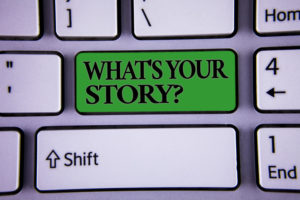Every organization has a story – what you want people to know about your organization, the good work you do, the people you help. Maybe the story you always tell is your mission.  Maybe it’s a story of needing help and resources to achieve your mission.
Maybe it’s a story of needing help and resources to achieve your mission.
The story you tell and how and where you tell it determines how effective it will be in moving to action the people you want to engage – whether you are trying to inform and motivate employees, clients, volunteers, donors, sponsors, legislators, the media or those who could be potential employees, volunteers, donors, clients, and sponsors.
Here are a few tips to make your story better resonate and motivate your audiences:
- Tell a story that will matter to the person/audience you are trying to reach, not just a story you want them to know. The more you can tie your story into their specific values, needs, and interests, the more effective it will be. This means that you should not use one story to motivate all audiences; you need different stories and messages for different audiences.
- Make it timely. Evergreen stories are less apt to catch the audiences’ attention and less apt to move them to action. They will be heard and forgotten quickly.
- As much as possible, put the story in context. For example, just don’t say we do good work in the community, quantify it. How many people did you help last year or will you help this year? How many lives did you impact? What specific things will a $50 donation help you do in the next two months?
- Humanize your story. The more you can put a face to the story, the more effective it will be in reaching the heartstrings and spurring action, whether that action is donating, volunteering or applying for the job. Make the story as personal as possible. Human interest pieces and case studies can be effective in the right circumstances.
- Understand that not everyone will be motivated immediately. The old advertising adage of reach and frequency applies. You must reach people – with a timely, effective message – and reach them frequently to be effective. But, frequently does not mean sending the same email frequently. If you do that, your emails will be relegated to spam and never read.
- Keep in mind that different stories will be better heard on different platforms. Some stories are best told through the media, others through blog posts, some on social media channels or though influencers, still others on your website and in printed materials.
Lastly, seek objectivity when determining what story to tell and how and when to tell it. Most people are so entrenched in their organizations and missions that they can not be objective in evaluating their stories and messages. It’s helpful to have someone outside your organization, such as a public relations consultant, look at your messages and stories and offer counsel to ensure they are clear, interesting, enticing enough to make them want to learn more and compelling them to action.
So what’s your story? Whatever it is, following these tips will help ensure it helps your organization achieve the results it wants.
